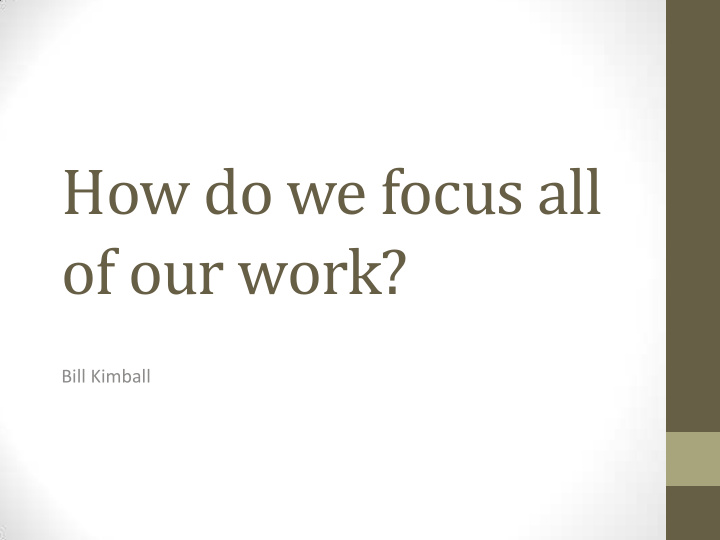



How do we focus all of our work? Bill Kimball
L et’s look at some history (Vermont) • 2003 – 2010 – High Schools on the Move, Roots of Success, World Class Education, Blue Ribbon Commission • Act 77 & 166 – Flexible Pathways - Dual Enrollment and Personalizing of Education (PLPs) & Universal Pre – Kindergarten • 2014 Update of Education Quality Standards • Curriculum and Instruction • Professional Resources • Learning Environment • State and Local Comprehensive Assessment System • Continuous Improvement Plan
L et’s look at some history (WCSU) • 2008 – 2013 Strategic Plan with 6 goals and 17 strategic objectives • 2012 – 2013 Development of Curriculum Council and Steering Committees, NEASC Review – Core Values and Beliefs • 2013 – 2014 Math Non-negotiables , U32 Student Learning Outcomes, WCLT North Star work (Vision) • 2014 -2015 Writing Non-negotiables, Calais & Doty SLOs • 2015 – 2016 Social Studies, Reading Non-negotiables, Rumney & EMES SLO • 2015 – 2016 WCSU SLO
So we have all these visions Doty School U-32 exists to cultivate in all Student Learning Outcomes students the passion, • Knowledge creativity and power to • Skills contribute to their local and Effective Effective • Attitudes Teaching and Teaching and global communities. Content Leadership Leadership Knowledge All students learn and are successful, Social and contributing Learning Skills & Personal citizens of our Techniques Responsibility local and global communities Effective Effective Key Teaching and Cognitive Teaching and Leadership Strategies Leadership Rumney students demonstrate personal Calais Elementary School will ensure all excellence meeting or exceeding rigorous its students show personal and academic standards for academic skills and growth, develop a love and commitment knowledge and life skills and behaviors to lifelong learning, and have the necessary for success in the 21 st century. strongest foundation for making future choices.
WCSU Student Learning Outcomes WCSU exists to nurture and inspire in all students the passion, creativity and power to contribute to their local and global communities. More specifically, WCSU students will meet or exceed rigorous standards for: Core knowledge of essential academic subjects, including: ● Literacy ● Mathematical Content and Practices ● Scientific Inquiry and Content Knowledge ● Global Citizenship ● Physical Education and Health ● Artistic Expression ● Financial Literacy Transferable skills and behaviors that prepare them for lifelong learning and success, including: ● Creative and Practical Problem Solving ● Effective and Expressive Communication ● Engaged Citizenship ● Working Independently and Collaboratively ● Informed, Integrated and Critical Thinking ● Self Awareness and Self Direction
HOW DO WE BUILD A SYSTEM THAT ENSURES ALL STUDENTS MEET THE WCSU STUDENT LEARNING OUTCOMES? HOW DO WE FOCUS ON THE CORRECT WORK, AT THE CORRECT TIME WITHOUT OVER TASKING THE SYSTEM?
WE NEED A 5 YEAR IMPLEMENTATION PLAN OF THE STUDENT LEARNING OUTCOMES
Process for Developing an Implementation Plan 1. Understand Current Work 2. Build a Team to do the Work 3. Data Review - Identify the Problems and Opportunities 4. Vision - Assess 5. Theory of Action 6. Develop an Implementation Plan
Understanding Current Work 1. Brainstorm the current initiatives 2. For each initiatives assess the following: 1. Impact on learning 2. Current performance 3. Resistance 4. Effort to completely implement 3. Sort into categories 4. Assess the number of students affected 5. Look for signs of strategy
Data Review - Identify the problems and opportunities • What we count? (Student Data) • What we see? (Supervision & Evaluation) • What do we hear? (Climate Data) • What are the key areas to focus on? p. 81 - 91 • Synthesize • Generate Classroom Performance and Assessment • Focus • Vet Student performance - content and skills Common Local State Assessments Assessments
Vision WCSU exists to nurture and inspire in all students the passion, creativity and power to contribute to their local and global communities.
Theory of Action • Identify Major Strategic Objectives • Map strategic objectives with a Theory of Action • Right grain size: in between boulder (too general) and sand (so detailed you’re lost in the weeds) • Being explicit can be scary and powerful: connections to accountability • Iterative: Theory, hypothesis, living document — gets sharper the more you discuss it, test it, revise it • Statement is phrased “If we do [Strategy 1], [Strategy 2], and [Strategy 3], then [vision]
WCLT’s Theory of Action If we provide high quality instruction and interventions that are responsive to learners’ needs and interests, based on clear learning targets, and measured by a comprehensive and balanced assessment system which include specific and actionable feedback to all, then we will close the achievement gaps and ensure that all students achieve proficiency in our WCSU student learning outcomes.
Next Steps • Review the feedback from you • Determine which initiatives to Start, Stop or Continue that align with our strategic objectives • Determine the logic model for each strategic objective • Activities • Resources • Outputs • Outcomes • Assumptions • Develop a work plan for each strategic objective • Determine roles and owners for actions within work plans • COMMUNICATE, COMMUNICATE, COMMUNICATE
Chart Talk Protocol At each board showing our work, there are two chart papers with the same focus question. We ask that each of you write an answer to our focus questions.
Recommend
More recommend